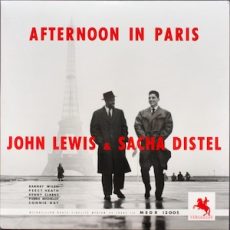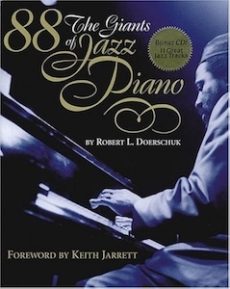
Requisites
Afternoon in Paris ~ John Lewis and Sacha Distel | By Eddie Carter
My mother was a big fan of The Modern Jazz Quartet, and today’s selection from the library highlights its founder and musical director, pianist John Lewis, joining French guitarist Sacha Distel on their 1957 collaborative album Afternoon in Paris (Atlantic 1267). It was one of her favorite records to play during our Sunday dinners growing up,and I had almost forgotten how enjoyable this album truly is. The supporting cast is superb: Barney Wilen on tenor saxophone, Pierre Michelot (tracks A1-A3) and Percy Heath (tracks B1-B3) on bass, Connie Kay (tracks A1-A3) and Kenny Clarke (tracks B1-B3) on drums. The copy I own is the 2021 French limited-edition mono audiophile reissue (Versailles MEDX 12005) released by Sam Records.
I Cover The Waterfront by Johnny Green and Edward Heyman, which opens side one, begins with John’s beautiful introduction. Sacha takes over to state the tasteful theme, and leads the way in a gorgeous reading. Barney has the last word in a warm performance that picks up pace until the pianist ends the way he began, softly. Dear Old Stockholm opens with piano, guitar, and tenor sax playing a brief segment of the melody, incorporating Pierre’s bass interlude, until it concludes. The pace picks up significantly for Barney’s swinging opening statement. Sacha delivers straight passion in the following solo, then John builds the third reading with smooth efficiency. All three soloists engage in a short exchange ahead of the pianist’s reprise and gentle ending.
The title tune, Afternoon in Paris by John Lewis, slows the pace to mid-tempo as the group begins the melody. Barney is the first to solo and cooks aggressively. Sacha steps in next to offer a splendid study in soulful improvisation. John makes his entrance with a perfectly locked-in groove. Pierre has the last word, and his sturdy bass lines lead the ensemble into the melody’s restatement. All The Things You Are by Jerome Kern and Oscar Hammerstein II gets side two underway with John’s pretty introduction. Barney launches into a swinging performance, then Sacha takes the reins and gets into a fantastic groove. John follows with a short solo, then he shares a brief word with Kenny before taking the song out softly.
Bags’ Groove by Milt Jackson got its title from the composer’s nickname. It opens with Barney stating the theme, leisurely, alongside Percy and Kenny. Sacha then begins the opening solo. John taps a creative vein next. Barney begins the third reading at ease, but gradually cruises to a satisfying climax. Percy and Kenny share a brief conversation preceding the theme’s reprise and summation. Ann Ronnell’s Willow Weep For Me begins with John’s gentle piano introduction, setting the stage for Sacha’s elegant, understated approach to the melody and his opening statement. The spotlight shifts to Barney, who delivers one of his most memorable solos on the album. John steps in last, providing a gorgeous improvisation that guides the ensemble to a graceful finish.
Although the producer of the original Afternoon in Paris session remains unidentified, Disques Versailles recorded the initial album, and Fred Thomas oversaw this audiophile reissue for Sam Records. The album’s sound quality is exceptional for a 1950s recording, with a warm, airy soundstage that makes you feel as if you’re in the studio with the musicians as they’re performing. It was remastered from the original tapes and pressed on 180-gram vinyl at Optimal Press using the Metal Mothers process from Pallas in Germany. This edition offers a listening experience that truly captures the album’s essence.
This was Sacha Distel’s sole album collaboration with John Lewis, yet both ensembles seamlessly integrate Lewis’s lyrical piano sensibility with Distel’s refined guitar elegance. The musicians’ interaction is both spontaneous and intuitive, culminating in six extraordinary performances. If you’re in the mood for an engaging blend of Bop and Cool Jazz, I cordially invite you to spend an Afternoon in Paris with John Lewis and Sacha Distel on your next record-shopping trip. I’m confident you’ll encounter a memorable album that will leave a lasting impression well beyond the record’s end!
~ All the Things You Are, I Cover The Waterfront, Willow Weep For Me – Source: JazzStandards.com ~Afternoon in Paris, Bags’ Groove, Dear Old Stockholm – Source: Wikipedia.org © 2026 by Edward Thomas Carter
More Posts: choice,classic,collectible,collector,guitar,history,instrumental,jazz,music,piano

Daily Dose Of Jazz…
Patt Casion was born Patt Spears on December 31, 1963 in the Monterey Peninsula, California and grew up in Marina where she learned to play music while at church. It was there she started building her musical chops that led to her attending Berklee College of Music in Boston, Massachusetts, where one of her classmates was Lalah Hathaway, daughter of Donny Hathaway.
Opportunity gave way to her playing local gigs and recording two albums and took her to many places around the world, one was as a member of the Church of God Christ International Orchestra based in Memphis, Tennessee.
Soprano saxophonist Patt Casion, who after a two year battle with cancer, died on December 31, 2017 at Community Hospital of the Monterey Peninsula at the age of 55.
More Posts: bandleader,history,instrumental,jazz,music,saxophone

On The Bookshelf
88: The Giants Of Jazz Piano
Ever wondered what made the piano gods of jazz so extraordinary? This captivating hardcover opens the door to 88 legendary artists who didn’t just play the piano—they transformed it into an instrument of revolution, soul, and pure genius.
Get ready to discover the fascinating stories behind the music. Each profile reveals not just what these pianists played, but who they were—their quirks, their breakthroughs, and the unmistakable fingerprints they left on jazz history.
The book takes you on an intimate journey with seven towering figures: Jelly Roll Morton, Earl Hines, Art Tatum, Thelonious Monk, Bud Powell, Keith Jarrett, and Cecil Taylor. But that’s just the beginning. You’ll also meet Mary Lou Williams, James P. Johnson, Count Basie, Duke Ellington, Nat “King” Cole, Dorothy Donegan, Oscar Peterson, Les McCann, Herbie Hancock, Dave Brubeck, Billy Taylor, McCoy Tyner, Chick Corea, Geri Allen, and 67 more innovators who pushed boundaries across every style imaginable—from stride’s joyful bounce to swing’s sophistication, bebop’s lightning-fast complexity to the fearless explorations of the avant garde.
At 344 pages packed with 100 stunning photos, plus a bonus CD featuring 11 essential jazz tracks, this is more than a book—it’s an experience. And with a foreword by Keith Jarrett himself, you know you’re in for something special.
Whether you’re a devoted jazz lover or just beginning your journey into this incredible art form, these stories will inspire, surprise, and maybe even change how you hear music.
88: The Giants Of Jazz Piano | Robert L. Doerschuk | Backbeat Books

Daily Dose Of Jazz…
Jerry Granelli was born Gerald John Granelli on December 30, 1940 in the Mission District of San Francisco, California. Both his father and uncle played the drums and were passionate about jazz. He initially learned the violin for a year, before switching to drums. He spent a day with drummer Gene Krupa in 1948 and hanging out at the Blackhawk and Jimbo’s Bop City soaking in Ellington, Miles, Monk and Max Roach eventually led to him studying with Dave Brubeck drummer Joe Morello.
After two years with Morello he became a highly sought-after session player, Jerry eventually started playing, recording and touring with the Vince Guaraldi Band. He provides the unmistakable steady swing beats for the classic Charlie Brown “Peanuts” theme song.
In the Sixties he moved on to the Denny Zeitlin Trio with bassist Charlie Haden. A hugely successful recording and touring band, they tied with Miles Davis for Group of the Year in Downbeat magazine’s Critics and Readers Poll in 1965. Throughout the decade he performed with Jimmy Witherspoon, Mose Allison, Lou Rawls, John Handy, Sonny Stitt, Sly Stone, Ornette Coleman and Dewey Redman. His free-form improvisational trio held down the opening slot for comedian Lenny Bruce for three months in 1963, and shared bills with Jefferson Airplane, Big Brother and the Holding Company and the Grateful Dead.
From the mid-70s through the 90s he focused on teaching, first at the Naropa Institute in Boulder, Colorado and then Seattle Washington’s Cornish Institute, the Conservatory in Halifax, Nova Scotia and the Hochschule der Kunst in Berlin, Germany.
During the 80s he toured and recorded in a trio with Ralph Towner and Gary Peacock, and began recording his own projects. From the Nineties until his death, Granelli lived in Halifax and became a Canadian citizen in 1999. In 2010, he released his first solo album, 1313, toured jazz festivals and theaters with his show Tales of a Charlie Brown Christmas, which retold how the Charlie Brown Christmas TV special almost never came to be.
Suffering from a fall in December 2020 that resulted in internal bleeding, he spent three months recuperating in an intensive care unit before being discharged. He died seven months later at the age of 89 on the morning of July 20, 2021, at his home in Halifax.
More Posts: drums,history,instrumental,jazz,music

Daily Dose Of Jazz…
Thore Ehrling was born December 29, 1912 in Stockholm, Sweden and played with the Frank Vernon Ensemble from 1930 to 1934. At the same time he studied at the Royal Swedish Academy of Music.
From 1935 to 1938 he played under Håkan von Eichwald and did arrangement and composition work on the side. He started his own ensemble in 1938, which grew into a big band in the nineteen years it was active. This group played popular music and jazz, recorded frequently, and played often on Swedish radio.
The group featured many sidemen who went on to become prominent on the Swedish jazz scene, such as Uffe Baadh and Carl-Henrik Norin, and accompanied popular Swedish singers such as Inger Berggren and Lily Berglund.
Trumpeter, composer and bandleader Thore Ehrling, who led jazz and popular music ensembles, died in Stockholm, Sweden on October 21, 1994.
More Posts: bandleader,composer,history,instrumental,jazz,music,trumpet



